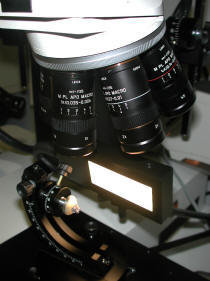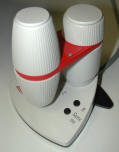Product Review
Leica
FS C Forensic Comparison Macroscope
by Scott Doyle
|

click image to enlarge |
Setup/Features-The
FS C
Opening the box containing the FS C
you will find a number of smaller boxes, the optical bridge and the FS C base. The small boxes contain accessories
including the stage parts, the fiber optic cables, the light sources, and
a number of miscellaneous items.
The base of the FS C was removed via two
large lifting rods that are screwed into both sides of the base. This is
definitely a two person operation! The base was set on the table and the
optical bridge was slid into place on the base via a dove-tail shaped connector. Once these two components were assembled
it was on to adding all of the various small parts and accessories.
At the top of the optical bridge is a
tilting binocular eyepiece that can be easily moved up and down. On the
opposite end of the optical bridge are
two nose pieces that will hold up to six sets of objectives.
 Mine
came with four sets of objectives, a .4X, 1X, 2X, and 4X, combined with
the 10X eye pieces for an effective magnification of 4X, 10X, 20X and 40X.
All of the objectives were attached and it was then on to the lighting systems. Mine
came with four sets of objectives, a .4X, 1X, 2X, and 4X, combined with
the 10X eye pieces for an effective magnification of 4X, 10X, 20X and 40X.
All of the objectives were attached and it was then on to the lighting systems.
My FS C came with two different fiber
optic light sources. One is a standard fiber optic system with light
diffusers on the end of each light cable. The second system attaches to
light boxes that provide a very diffused softer light. The light sources
of each system will allow for adjustments of the light temperature from 2550K to
3000K degrees.
 The
support systems for the lights are fully adjustable and two different support
systems were included. One system has a multi-elbowed arm that is loosened
for movement with the turn of a single knob. The light can be positioned
and then locked down by tightening the knob. The
support systems for the lights are fully adjustable and two different support
systems were included. One system has a multi-elbowed arm that is loosened
for movement with the turn of a single knob. The light can be positioned
and then locked down by tightening the knob.
The other support system is
mounted above the optic nose piece and provides precise positioning of the
lights. This allows for the lighting angle to be exactly reproduced on
both stages. So, if you need your light to be exactly the same on both
stages, this is the system you would want to use.
Located
in the base of the FS C is what is called the "Central Control Module". Sitting squarely between the two stages, the control module is loaded with buttons, wheels and knobs.
 It contains everything needed to: It contains everything needed to:
-
control the movement of the stages,
-
adjust light intensity from the light sources,
-
control the position of the dividing line within the scope's field of
view,
-
sync the movement of the stages,
-
raise and lower the motorized optical bridge, and ... whew, if that isn't
enough,
-
increase the magnification of the image by a 1.5X factor.
More on the Control Module later!
 Also
included with the FS C is what is called a SMARTMOVEtm
3-D control device. This little unit
sits either on the right or left of the FS C (actually you can hook two of these to the
FS C) and is used to control the X, Y, and Z movement of the stages in a way that
very closely mimics the stage controls of the older AO scopes I have used.
The big exception is that this control unit is completely electronic. It
has buttons that switch the control from to either stage and to sync the
movement of both stages. Also
included with the FS C is what is called a SMARTMOVEtm
3-D control device. This little unit
sits either on the right or left of the FS C (actually you can hook two of these to the
FS C) and is used to control the X, Y, and Z movement of the stages in a way that
very closely mimics the stage controls of the older AO scopes I have used.
The big exception is that this control unit is completely electronic. It
has buttons that switch the control from to either stage and to sync the
movement of both stages.
In assembling the FSC there are a bunch of
power cables to deal with. The optical bridge, both stages, the SMARTMOVEtm
unit, and both light sources connect to the back of the FS C base. A
serial port is also included to allow your FSC to be connected to a computer and
a second connector is available for another SMARTMOVEtm unit. Two additional
connection points labeled "left" and "right" are there (you can see them below)
but I have no idea what they are for. I can only guess that they are for
an accessory I didn't get.

Once all of the cables were connected the
FS C was powered up via an on/off switch located on the right side of the base.
Ready to fire it up? Okay, here
goes!
Next-Power-Up!
|